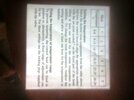- Joined
- 27 Sep 2022
- Messages
- 297
- Reaction score
- 23
- Country

but that would defeat the purpose of heating, wouldn't it?The easiest way is to just decrease the temperature setting of the TRV, but as stated above at the expense of a colder room, its not much fun having a return temperature of 27C but a cold room. You could also let the TRV setting as is and set the flow temperature to say 70C and let the TRV act as a on/off control but apart from probably getting room temperature overshoot/undershoot you will still use more gas as the rad demand is higher.
What would happen if we oversize the rad but keep the flow rate at 50?

